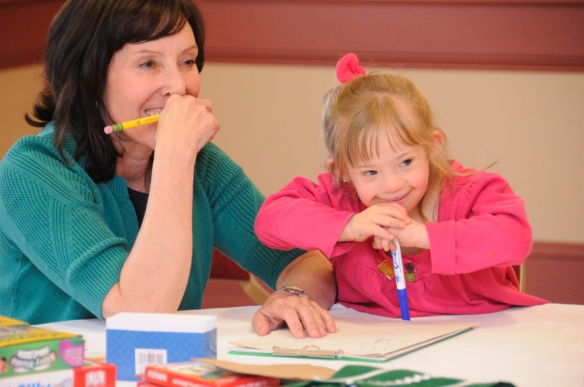I took a seminar once called “The Reading Brain.” It was a required part of my Orton Gillingham training. I remember being a bit concerned when the instructor handed out a two-page “Brain Word Bank” and I didn’t recognize 90% of the terms, but I was reassured when the first activity was coloring in different areas of the brain with florescent markers.  While initially intimidating, neuroscience soon captivated me. I was fascinated to discover the individual “jobs” of various brain parts, and how the parts work together to accomplish the complex task of reading. I was intrigued by MRI scans of the brains of children with and without dyslexia, taken while they were reading. The scans showed that the part of the brain that was supposed to “light up” during the reading process did not seem to fire for kids with dyslexia. Yet, in spite of this, children with dyslexia do learn to read. With the right intervention, other parts of the brain can be trained to perform the function of the part that is not performing efficiently.
While initially intimidating, neuroscience soon captivated me. I was fascinated to discover the individual “jobs” of various brain parts, and how the parts work together to accomplish the complex task of reading. I was intrigued by MRI scans of the brains of children with and without dyslexia, taken while they were reading. The scans showed that the part of the brain that was supposed to “light up” during the reading process did not seem to fire for kids with dyslexia. Yet, in spite of this, children with dyslexia do learn to read. With the right intervention, other parts of the brain can be trained to perform the function of the part that is not performing efficiently.
This made me think of my college students when I assign cooperative group projects. I sometimes overhear them “collaborating.” Student 1: “Um, I am pretty sure that was YOUR job. Now, because you didn’t do what you were assigned to do, we’ve wasted valuable time and might even miss the deadline.” Student 2: “Was that my job? I thought you were in charge of that. I was kind of busy doing this other thing.” Student 2: “Well, its too late to make up for it now. And just so you know, Student 3 has had to work twice as hard to do her stuff AND yours in order to get this project finished.”
That is how I imagine the dyslexic brain; struggling with the collaborative process of deciphering text and finding that a member of the group is slacking off, causing the others to have to work twice as hard to make up for it. But in the end, the task is accomplished. Not as quickly, not as easily and not in the hoped-for way, but it is accomplished.
I have always found this knowledge of the brain reassuring, because it provides us with valuable information about how to teach reading to children with dyslexia. So I was excited to learn that, like children with dyslexia, children with Down syndrome share a set of learning characteristics that are rooted in the neuroscience of their brain development. These characteristics affect language and literacy growth in ways that will be very familiar to any parent or teacher who has ever taught a child with Ds to read. Here is my non-scientific look at a some of these characteristics and how they may come into play when children with Ds set about to conquer the written word:
Memory, information processing and motivation:
- Weak auditory working memory, i.e. difficulty holding information in short-term memory while performing other cognitive processes. For example, recalling the sound-symbol associations for letters while blending the sounds together to make a word or sounding out words while simultaneously thinking about their meaning.
- Relative strength in tasks requiring “implicit” memory (things you do every day without really thinking about them, such as singing a song or signing your name).
- More difficulty with “explicit” memory (remembering facts, such as the names of letters, telephone numbers or computer passwords).
- Strong visual learners (excel at memorizing sight words).
- Difficulty processing and remembering information presented orally (struggle with phonological awareness).
- Often motivated by social interaction.
- May use social interactions to avoid tasks they find challenging.

How does this translate into recommendations for instruction?
- Incorporate training in phonological awareness skills from a very early age
- Use a multi-sensory approach to teaching, including a strong visual component and manipulatives
- Provide lots of opportunity for repetition
- Model skills, strategies and expected behaviors
- Allow wait time for responses
- If needed, build in outside motivators (such as having a child track her own progress on an iPad graphing application) to compensate for low motivation or task persistence
- Be sure that when the child is practicing a new skill, you are there to provide feedback (so the skill is practiced correctly until it is automatic)
To learn more, check out this research:
Improving Memory in Children with Down Syndrome—a research update from Down Syndrome Education International. Somewhat technical but includes helpful explanations of complex processes as well as a wealth of references.
Enhancing Reading Instruction for Children with Down Syndrome –a three-year study by Dr. Christopher Lemons and colleagues, University of Pittsburgh.